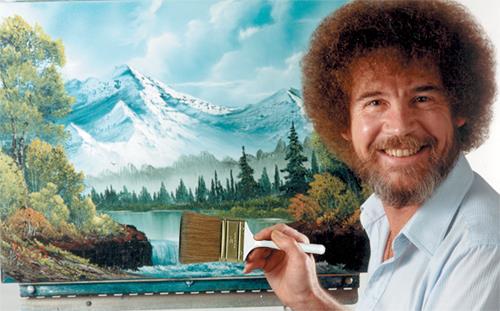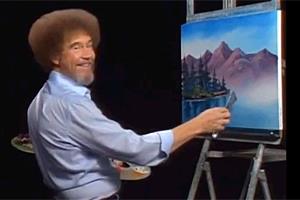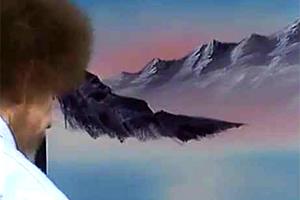
When Bob Ross called his PBS show The Joy of Painting, he meant it.
And now, 20 years after his tragically early death, anyone who owns a computer can watch one of the most useful and enduring instructional art shows ever carried on television.
Seventy episodes of The Joy Of Painting, culled from the 381 episodes Ross filmed over 12 years on PBS, 1983-1994, have just been made available on his YouTube channel. In addition, the complete first season is available.
Each episode is titled for the painting Ross completes during that half hour. The titles include “Mystic Mountain,” “Valley View,” “Evening Peace,” “Final Grace,” “Black Waterfall” and, well, you get the idea.
 Ross painted landscapes – relaxing, idyllic pastoral scenes that almost always included trees, along with mountains, clouds, water and wildlife.
Ross painted landscapes – relaxing, idyllic pastoral scenes that almost always included trees, along with mountains, clouds, water and wildlife.
He loved squirrels and other furry woodland critters almost as much as he loved those trees, which he called “happy little trees” at every opportunity.
There was a “kid who never grew up” spirit in Ross, and it has been noted that he even sounded a little like Mr. Rogers, another perpetually nice TV character.
But Ross’s show, unlike Mr. Rogers’ Neighborhood, was aimed at grownups. While kids were welcome to watch, and Ross kept his instruction at a basic level they could follow, his real target audience was people who always wanted to paint and never thought they could.
Ross scoffed at that reluctance. If everyone couldn’t sing or play professional tennis, Ross was convinced that anyone who was willing to devote the time could turn out a decent painting.
If they followed Ross’s lead, they could also do it quickly. He worked in oils, and because they take some time to dry, he didn’t bother to let them. He painted “wet on wet,” which means dabbing the next layer of color on top of the previous one while it’s still moist.
Not everyone paints that way, but it served Ross’s purpose, and since he wasn’t painting portraits or other subjects that required fine minute detail, he could get away with letting the results be.
“I don’t know where it goes,” he said about a tree in one episode. “We don’t really care.” He was a fan, he said in another episode, of “happy accidents.”
Born in Florida in 1942, Ross served in the Air Force and later said that experience made him vow never to scream again. Since he had two wives and three sons, he may not have always kept that vow in private, but he did on the TV show.
He spoke slowly, with an almost eerie calm, and his patter was both constant and genial. Most of it focused on painting, but he was fond of incidental one-liners like, “This tree is crooked. Let’s send it to Washington.”
 His paintings reflected that serenity, with their aura of comforting warmth. Since he worked fast, he estimated he finished more than 30,000 paintings in his lifetime. They created the core for a $15 million Bob Ross business that also included his instructional videos, art supplies and ancillary products.
His paintings reflected that serenity, with their aura of comforting warmth. Since he worked fast, he estimated he finished more than 30,000 paintings in his lifetime. They created the core for a $15 million Bob Ross business that also included his instructional videos, art supplies and ancillary products.
He did all this before he was 52, when he died of lymphoma.
Purely as an artist, Ross wasn’t one of America’s best. But the other part of his mission, showing viewers that painting wasn’t a scary enterprise accessible only to an unusually gifted few, was remarkably successful.
As an instructor, Ross was most valuable to people just beginning to paint, or those who previously found it intimidating. He carefully explained the basics, step by step, in simple and understandable terms. With each new painting he added more details about why you do this, or what effect it has when you do that.
At some point, most viewers who wanted to become serious painters would outgrow Ross – graduate, perhaps, to more sophisticated techniques and more complex subject matters.
But most took with them the fundamentals he had laid out, and those fundamentals remain as sound for new painters today as they were a quarter century ago.